Mary Magdalene – The Provençal Tradition
There is a widely recognized, time-honored alliance between Mary Magdalene and Provence—South of France. Two significant sites of pilgrimage bear witness to this claim: the Basilica of Saint Mary Magdalene in St.-Maximin-la-Sainte-Baume and La Sainte-Baume, a mountain cave on the plain of the Plan d’Aups, overlooking the Massif de la Sainte-Baume.
Tradition has it that, after the execution of St. James in Jerusalem (son of Zebedee and Mary Salome), Mary Magdalene, her sister Martha and brother Lazarus were persecuted by the Jews of Jerusalem and imprisoned. The Jews were afraid of the crowd if they were to execute the prisoners so they towed them off the shores of Palestine in a boat without sails or oars or supplies and abandoned them to the open sea. Others in the boat included Mary Jacobe, mother of James and the sister of the Virgin Mary, Mary Salome, mother of the apostles James and John, Maximin, one of the seventy two disciples of Christ, Cedonius, the blind man who was miraculously healed by Jesus, Marcelle, Martha’s servant, and Sara, maid of the two Marys.
After narrowly escaping death during a storm at sea the boat finally came to shore on the coast of Gaul in a town now called Saintes-Maries-de-la-Mer in Camargue.
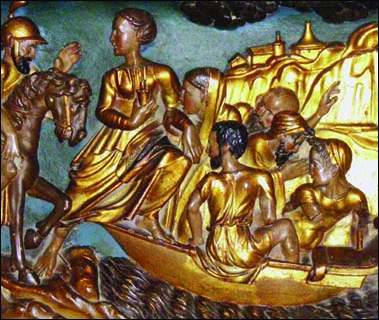 Low relief, in gold-leafed wood, from the altar of the Rosary in the Basilica of Saint Mary Magdalene, depicts Mary Magdalene and her companions being sent off to sea.
Low relief, in gold-leafed wood, from the altar of the Rosary in the Basilica of Saint Mary Magdalene, depicts Mary Magdalene and her companions being sent off to sea.
Mary Jacobe, Mary Salome and Sara remained in Camargue. Martha traveled towards Avignon and ended up in Tarascon. Mary Magdalene, Lazarus, Maximin and Cedonius traveled on to Marseille where Mary Magdalene began to preach. They ended up converting the whole of Provence. Lazarus became the first bishop of Marseille. Mary Magdalene then went on to Aix where Maximin had already gone, some twenty miles north of Marseille.
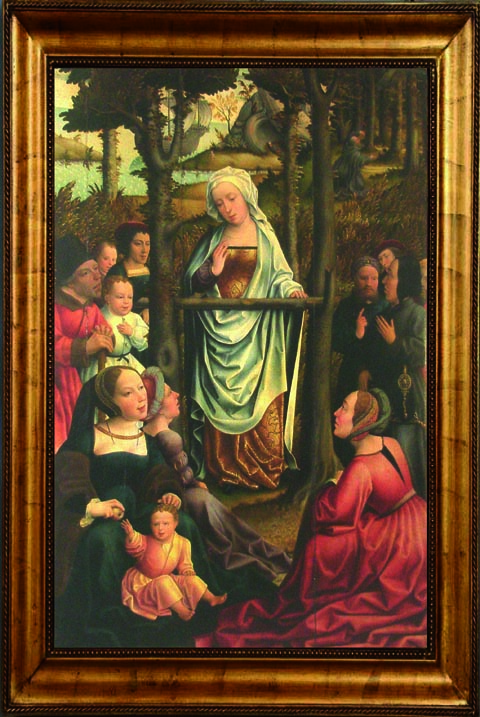 Mary Magdalene Preaching in Marseille (c. 1518), Philadelphia, Museum of Art, Johnson Collection.
Mary Magdalene Preaching in Marseille (c. 1518), Philadelphia, Museum of Art, Johnson Collection.
Maximin became the first bishop of Aix and Mary Magdalene retreated to a mountain cave on the plain of the Plan d’Aups known as La Sainte Baume (47 AD) where she remained alone for the last thirty years of her life in contemplation, prayer and penance. She is said to have been lifted up by the angels seven times each day at the canonical hours and fed heavenly nourishment. The tiny chapel of Saint Pilon on the crest above La Sainte Baume was built in memory of Mary Magdalene being raised by angels.
When the time of Mary Magdalene’s death arrived she was carried by angels to the oratory of Maximin, where she received viaticum. She died in Maximin’s arms and her body was laid in an alabaster sarcophagus in an oratory he constructed in the Gallo Roman town of Villa Latta or Tégulata, which after Maximin’s death became St. Maximin.
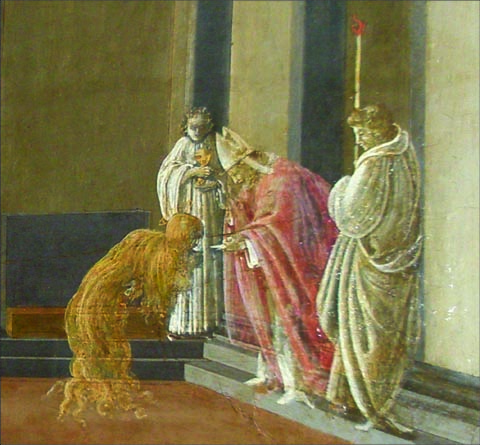 Scene from the Legend of Mary Magdalene, Mary Magdalene Receiving Viaticum by Sandro Botticelli (c. 1484-9), Philadelphia, Museum of Art, Johnson Collection.
Scene from the Legend of Mary Magdalene, Mary Magdalene Receiving Viaticum by Sandro Botticelli (c. 1484-9), Philadelphia, Museum of Art, Johnson Collection.
Maximin, Cedonius and Marcelle are buried at St. Maximin. Mary Jacobe, Mary Salome and Sara are buried in the parish church in Saintes-Maries-de-la-Mer. Martha is buried in St. Martha’s Church in Tarascon and the skull of Lazarus is in a reliquary at Cathedral of Saint Mary Major in Marseille.
Dominicans appointed as Guards of the Relics of Saint Mary Magdalene
In 1254, returning from the seventh Crusade, Saint Louis, king of France, on hearing of La Sainte Baume, greatly desired to visit it with his knights; this royal pilgrimage ended up having great repercussions.
Mary Magdalene Relics Unearthed in 1279
In 1279, St. Louis’ nephew, Charles II (Prince of Salerno and Count of Provence) acquired knowledge that the relics were buried in the town of St. Maximin in the church with the same name, so he ordered excavations in Saint Maximin to search for them. On December 10, 1279, deep in the earth, he found the marble tomb. When he tried to open it a wonderful smell of perfume filled the air. Inside lay her entire body except her jaw bone. In the dust inside the tomb was a wooden tablet wrapped in wax:
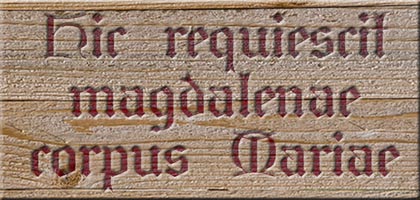 Here lies the body of Mary Magdalene
Here lies the body of Mary Magdalene
“Here lies the body of Mary Magdalene” and a parchment which explained that in 710 her remains had been secretly transferred during the night into the marble tomb of Cedonius and hidden so that the Saracens wouldn’t find them.
On April 6, 1295 the skull was reunited with its jaw bone at St. John Lateran in Rome where it had been venerated for centuries, thanks to Pope Boniface VIII, who then published the pontifical bull for the establishment of the Dominicans at La Sainte Baume and St. Maximin. Some years later the Basilica of Saint Mary Magdalene was built over the spot where Charles II found her remains. A Dominican priory was built in St. Maximin as well as a little priory at La Sainte Baume.
Since then hundreds of thousands of pilgrims, including many kings and popes and saints, have continued to journey to La Sainte Baume and St. Maximin to pray to and to give thanks for the intercession of Saint Mary Magdalene.
Mary Magdalene Relics – Her Skull
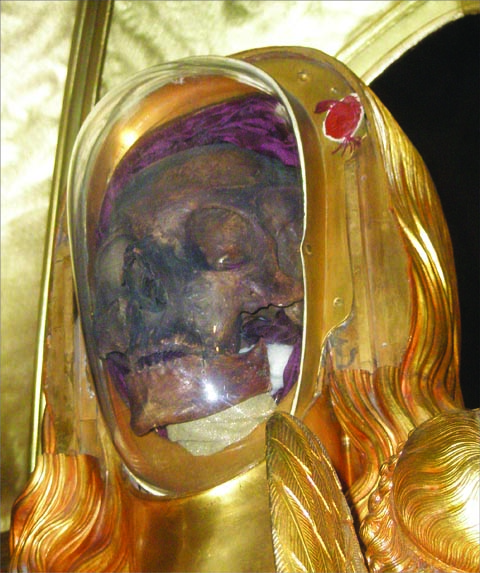 Today the skull of Saint Mary Magdalene along with her jaw bone are in a gold reliquary in the Basilica of Saint Mary Magdalene in St. Maximin-la-Sainte-Baume.
Today the skull of Saint Mary Magdalene along with her jaw bone are in a gold reliquary in the Basilica of Saint Mary Magdalene in St. Maximin-la-Sainte-Baume.

